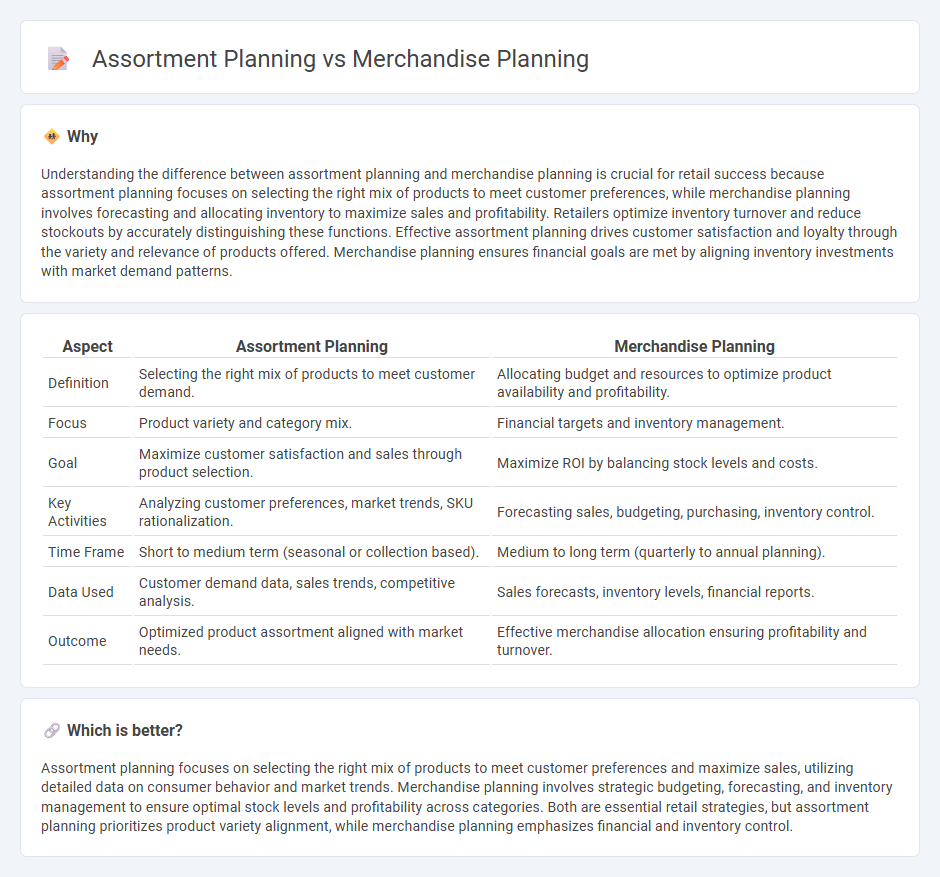
Assortment planning focuses on selecting the right mix of products to meet customer demand and optimize sales within specific categories or locations. Merchandise planning involves forecasting sales, budgeting inventory, and setting pricing strategies to maximize overall profitability across the entire retail operation. Discover how mastering these key strategies can enhance retail performance and boost profitability.
Why it is important
Understanding the difference between assortment planning and merchandise planning is crucial for retail success because assortment planning focuses on selecting the right mix of products to meet customer preferences, while merchandise planning involves forecasting and allocating inventory to maximize sales and profitability. Retailers optimize inventory turnover and reduce stockouts by accurately distinguishing these functions. Effective assortment planning drives customer satisfaction and loyalty through the variety and relevance of products offered. Merchandise planning ensures financial goals are met by aligning inventory investments with market demand patterns.
Comparison Table
| Aspect | Assortment Planning | Merchandise Planning |
|---|---|---|
| Definition | Selecting the right mix of products to meet customer demand. | Allocating budget and resources to optimize product availability and profitability. |
| Focus | Product variety and category mix. | Financial targets and inventory management. |
| Goal | Maximize customer satisfaction and sales through product selection. | Maximize ROI by balancing stock levels and costs. |
| Key Activities | Analyzing customer preferences, market trends, SKU rationalization. | Forecasting sales, budgeting, purchasing, inventory control. |
| Time Frame | Short to medium term (seasonal or collection based). | Medium to long term (quarterly to annual planning). |
| Data Used | Customer demand data, sales trends, competitive analysis. | Sales forecasts, inventory levels, financial reports. |
| Outcome | Optimized product assortment aligned with market needs. | Effective merchandise allocation ensuring profitability and turnover. |
Which is better?
Assortment planning focuses on selecting the right mix of products to meet customer preferences and maximize sales, utilizing detailed data on consumer behavior and market trends. Merchandise planning involves strategic budgeting, forecasting, and inventory management to ensure optimal stock levels and profitability across categories. Both are essential retail strategies, but assortment planning prioritizes product variety alignment, while merchandise planning emphasizes financial and inventory control.
Connection
Assortment planning and merchandise planning are intrinsically linked in retail, as assortment planning determines the variety and mix of products offered to meet customer preferences, while merchandise planning allocates budget and inventory levels to support these assortments. Effective collaboration between these processes ensures optimal product selection aligns with sales forecasts, inventory turnover rates, and seasonal trends. This integration drives increased sales performance and maximizes profit margins by balancing consumer demand with operational execution.
Key Terms
Merchandise planning: Open-to-Buy, Sales Forecasting, Inventory Turnover
Merchandise planning involves strategic decision-making on Open-to-Buy budgets, precise Sales Forecasting models, and optimizing Inventory Turnover rates to maximize profitability and minimize stockouts. It ensures the right product quantities and values are purchased for specific time periods, balancing supply with anticipated consumer demand. Explore further to understand the critical metrics that drive effective merchandise planning and boost retail success.
Assortment planning: SKU Rationalization, Product Mix, Space Allocation
Assortment planning focuses on SKU rationalization by identifying high-performing products to optimize inventory and reduce redundancy within the product mix. Effective space allocation strategies ensure maximum sales per square foot by aligning product placement with consumer demand and store layout. Explore our comprehensive guide to enhance your assortment planning and boost retail performance.
**Merchandise planning:**
Merchandise planning involves forecasting demand, setting financial goals, and allocating budgets across product categories to optimize inventory and sales performance. It ensures the right products are available at the right time and price, enhancing profitability and customer satisfaction. Discover more about how merchandise planning drives retail success and inventory efficiency.
Source and External Links
What Is Merchandise Planning? | Key Elements and Process - Merchandise planning helps retailers optimize inventory and forecast demand by balancing product assortment, inventory management, and customer needs through market research and demand forecasting.
What Is Merchandise Planning? Elements and Process ... - Merchandise planning is a systematic approach involving post-season analysis, pre-season planning, and in-season adjustments, tailored by product categories and retail business types based on consumer demand.
How to create an effective retail merchandise plan - QuickBooks - The merchandise planning process includes analyzing past sales, forecasting future sales, and incorporating current trend data to plan inventory and product assortment for the upcoming season.
 dowidth.com
dowidth.com